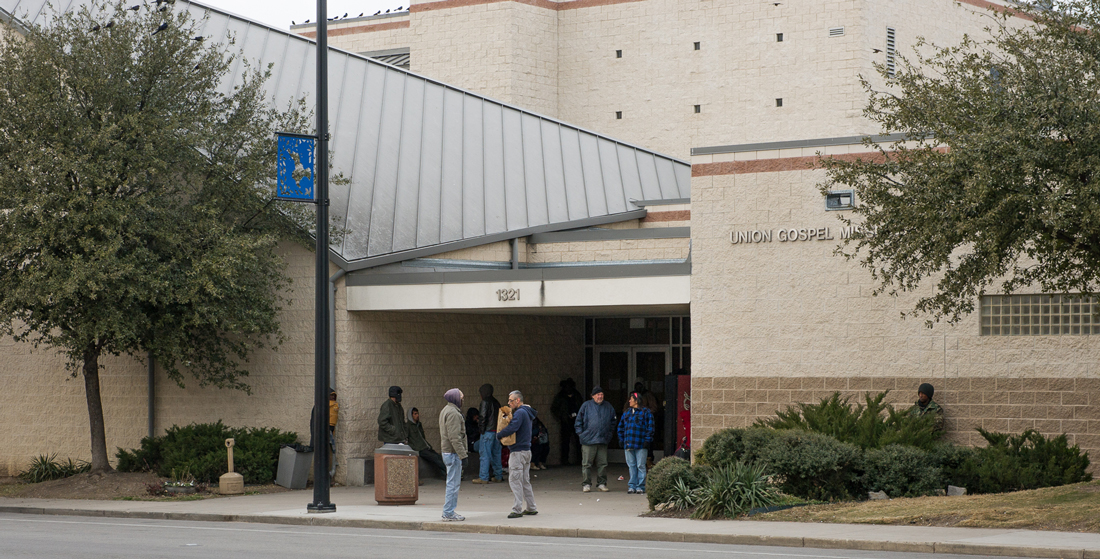Six years ago when the city adopted a 10-year plan to end homelessness in Fort Worth, officials promised to start finding ways to get people out of what Eastside residents call the shelter district along East Lancaster Avenue. The area is a centralized hub for agencies serving the city’s more than 2,000 homeless people.
Since the Directions Home plan launched, the city has found homes for 1,200 residents through what it calls a “housing first” strategy, which places homeless people in permanent housing and provides services to help them stay off the streets. Though the city’s homeless population grew last year, it is still 20 percent smaller than it was in 2007, the year before the plan took effect.
Still, the streets around East Lancaster Avenue are filled with droves of homeless men and women, the surrounding areas are dotted with makeshift camp sites, and many storefronts of the once-bustling area have sat vacant for years. Neighborhood business owners say the shelters make the spaces undesirable for potential tenants.
Last week, when the Fort Worth City Council voted to approve a site plan allowing Union Gospel Mission of Tarrant County to replace its one-story, 7,000-square-foot Scott Walker Women and Families Services Building with a four-story, 40,000-square-foot building, many Eastside residents and business owners saw the move as a huge step backward.
Though they were complimentary of the work the 125-year-old mission does, Eastside leaders said the planned expansion of the family services building shows how the promising 10-year plan has stalled and that the city is no longer serious about solving the problem of homelessness. They are calling for officials to follow the plan laid out by then-mayor Mike Moncrief, to find apartments and homes for people, as opposed to just addressing it as an insoluble, permanent situation.
One of the core tenets of Directions Home, said Rita Vinson, who served on the Planning and Advisory Committee on Homelessness that created the plan, was to get people out of shelters and transition the population back into mainstream society.
But now, she said, “The 10-year plan lies on the shelf and continues to collect the dust of neglect because of the lack of city leadership. Taking the path of least resistance is not leadership.”
Supporters of the centralized shelter district argue that having such an area makes helping the homeless far easier.
Otis Thornton, the city’s homelessness program director, said he is proud of the strides Fort Worth has made and gave credit to both the public and private sectors for that progress. But he also acknowledged some of the program’s shortcomings.
“On some measures, we have done a good job, and on others, we still have a ways to go,” he said. “For example, while our numbers went up last year for the first time, homelessness is still more rare than it was when the Directions Home plan was crafted, despite a staggering recession that took a huge toll on low-skill and low-wage workers.”
Union Gospel’s old center for women and children has already been torn down in anticipation of the new project. But even when its rooms were still available, the shelter was turning away about 200 families a month for lack of space, administrators said. Currently, when a family with both parents shows up, one member of the couple has to sleep elsewhere.
The new facility is planned to have triple the occupancy of the old one and will allow more of the two-parent families to stay together.
“In the building we tore down, the occupancy was 32, and this building will house 100 to 110,” said Union Gospel President Don Shisler. “It’s really not that many.
“We have more than 300 residents every night,” he said. “We service an additional 300 to 400 people daily who come in to eat, or they may do a [religious] service with us, or we may give them food or some kind of direction.”
Shisler wouldn’t comment on the criticisms of the expansion plan leveled by residents and business owners.
He said mission officials have also discussed building more transitional apartments in the area, but those are only “visions for the future.”
Until last month, Eastside residents interviewed for this story thought the $8.2 million project had successfully traversed the bureaucratic obstacle course. But the project hit a snag when new building plans were submitted to the city in October. The initial site plan approved in 2002 limited the building to one story.
The amended plan required city council approval, and when the subject was brought up again at a council meeting in December, critics saw it as an opportunity to address the larger problem.
Eastside residents and business owners told the council they are opposed to housing families amid the general homeless population, which includes sex offenders and other criminals. As it stands today, there are 76 registered sex offenders in the area.
Mike Phipps, code enforcement chairman of the nearby West Meadowbrook Neighborhood Association, said the portion of homeless population who aren’t looking to get back on their feet pose a threat to the surrounding areas.
“They are the ones that are coming into the neighborhoods and setting up camp,” he said. “They’ll find a vacant property and take it over. Then of course we’re down at building standards [department] asking for [the building] to be torn down.”
Nearby resident Wanda Conlin said she sees a twice-daily migration to and from the shelters as the homeless fan out into the neighborhoods every morning and head back at night.
“This is a dangerous neighborhood,” she said “It’s dirty. Kids are seeing things they shouldn’t ever see. This is just not the right way to treat people who are homeless.
“For 20 years I’ve been saying this is wrong,” she said. “It’s a political hot potato, because it makes everybody who says ‘Don’t do this’ seem heartless and mean. We’re not.”
Local business owner Bob Gallant, whose Gallant Marble & Granite storefront has been on East Lancaster since 1976, said he has seen the neighborhood go from a thriving economic center to a terrible place to conduct business.
He said he felt deceived by city officials and the Union Gospel Mission’s project planners.
“At our neighborhood association meeting, they told us their plans for the four-story building, and they said it was already a done deal,” said Gallant, who also co-founded the Near Eastside Neighborhood Association. “That’s when the association voted to send a letter of support. Then we got an e-mail saying it wasn’t approved, and it still had to go before zoning [commission].
Had he known it wasn’t a done deal, he said, he “definitely wouldn’t have voted to support it. I would have fought it.”
The city council voted 6-1 in favor of the amendment, with the only dissenting vote cast by council member Kelly Allen Gray, whose district includes the shelters.
Vinson said that when she and the task force came up with the original 10-year plan, even some among the homeless population spoke out against a centralized hub.
“We had a homeless person speak to our committee, and he said having it centralized makes it very difficult for the people there who are going through programs to get sober or clean,” she said. “They are bombarded with people pushing drugs, prostitution, whatever. It would be easier for them to get their lives together if they weren’t in the midst of all of that.”
Gray said she believes that there is already enough housing available for homeless families, “but all of the housing is in southeast Fort Worth: Woodhaven and up and down Lancaster. We have to do a better job of looking at it and spreading those citizens out. How about having people of different income levels living together?”
Thornton said the city hasn’t taken its eye off the ball, and the goal is still to get homeless people out of “crisis services” such as shelters. But, he said, finding affordable permanent housing all over town isn’t as easy as it sounds.
“The Directions Home plan advocates for the dispersion of quality, affordable, accessible housing throughout the city,” he said. But, “like cities across America, housing in Fort Worth that is affordable to people making minimum wage tends to be more clustered.”
Last week, area residents launched Vision East Lancaster, which Gray explained was a collection of community leaders focused on revitalizing East Lancaster Avenue, Riverside Drive, and Handley Drive. The group has been meeting for more than a year under the name East Lancaster Revitalization Committee.
“We’ve put together a plan where we started reaching out to different business owners to give them an opportunity to express some of their concerns and also to point out good things that are happening along East Lancaster,” she said.
The committee wants to “create something that will allow that corridor to start bringing people back to do business on East Lancaster,” she said. The group will partner with Texas Christian University marketing students to help promote it.
Conlin was one of the first people on the revitalization committee –– it was she who asked Gray to join. She said that Downtown Fort Worth Inc. is her model for the group.
“It’s a long process,” she said. “We didn’t get this way overnight, and it’s going to be a long process to get out.”













Don Shisler is one of the biggest liars in Fort Worth. The Union Gospel Mission is not about helping people. They are about keeping people homeless and depending on them so they can continue getting federal funding, even though they claim that they don’t receive any government funding. They should be shut down completely.
The Union Not So gospel Mission started as a great idea I am sure. Now it is simply another money hungry place that cares about nothing or nobody but themselves. It is a way for so called Christians to massage their ego by being able to say I help those poor unfortunate people.
At the City Council meeting, everybody who came forward to speak on the wArm fuzzy feelings they get from helping the homeless drove in from somewhere else. They don’t live with grown men who pull out their penises and pee on the sidewalk without even turning their back.
UGM is a multi million dollar entity and wants homelessness to continue so that their funding source won’t dry up. they get these people hooked on social services so they will always be just one step away from being homeless. UGM takes donations for residents picks the best out and sells it at a sale in another area of fort worth. Then when a resident gets housing ( from other agencies, as UGM has no programs for this at all), they give them broken and junk items. I have seen several former residents that had the donations brought to them and had to throw 80% in the trash as it was unusable or simply trash to begin with.
Not to mention selling the good things that they get. These are things that are meant for the homeless. The kitchen staff taking home food that is meant for the homeless. They also use expired food to serve to residents and guests. They force people to go to chapel. Attention donors, if you bring any prepared food, they throw it away and no one (except paid employees) get it. I would advise people to not donate to them.
At the City Council meeting, everybody who came forward to speak on the wArm fuzzy feelings they get from helping the homeless drove in from somewhere else. They don’t live with grown men who pull out their penises and pee on the sidewalk without even turning their back. They pass untold numbers of homeless people in their own communities to come here and grow the population in someone else’s neighborhood.
Wait! TCU has tried to clean up Lancaster since before 1985 and apparently got nowhere. I know because I used to live near there back then, and called the city who sent me to TCU’s Lancaster project. Imagine how this info gets buried so easily. Imagine how suddenly they are going to boast of being the knight in shining armor. They couldn’t help 30 years ago?
I’m suspicious of appropriated funds because I heard that Denver Moore and Ron Hall raised $12 million so the homeless had homes – given to the union gospel mission – not for a facelifted shelter. They also raised $85m for the homeless from the “same kind of different as me foundation”. I wonder where all that money is??? You gotta wonder what the bankers and wealthy are really doing here. As usual, I don’t see any homes that aren’t costing the homeless/unemployed less than the banking standard of 30% of their income. No help. I’m going to dig deeper on this fiasco. I swear, people with money are so disconnected from compassion and integrity. They want bragging rights for other cities on how to make it look like something it isn’t in reality. I hope my suspicions are wrong and someone corrects me, but I have my doubts.